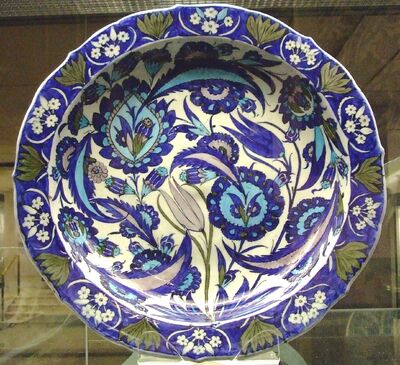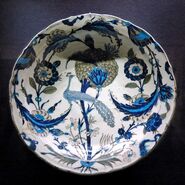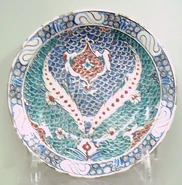
Iznik dish in saz and rosette style in the British Museum's collection
Iznik pottery, named after the town in western Anatolia where it was made, is highly decorated ceramics whose heyday was the late sixteenth century. The largest collection of vessels is in the British Museum and Iznik tiles may be seen in quantity in the imperial and religious buildings of Istanbul.
History[]
Overview: role of Chinese porcelain[]
Right image: Stone-paste dish with grape design, Iznik, Turkey, 1550-70. British Museum.
Following the establishment of the Ottoman Empire in the early 14th century, Iznik pottery initially followed Seljuk Empire antecedents.
After this initial period, Iznik vessels were made in imitation of Chinese porcelain, which was highly prized by the Ottoman sultans. As the potters were unable to make porcelain, the vessels produced were fritware, a low-fired body comprising mainly silica and glass.
The originality of the potters was such that their use of Chinese originals has been described as adaptation rather than imitation.[1] Chinese ceramics had long been admired, collected and emulated in the Islamic world. This was especially so in the Ottoman court and the Safavid court in Persia which had important collections of Chinese blue-and-white porcelain. Such Chinese porcelains influenced the style of Safavid pottery and had a strong impact on the development of Iznik ware.[2] By the mid-16th century, Iznik had its own vocabulary of floral and abstract motifs in tight designs making use of a limited palette. Decoration progressed from pure symmetry to subtle rhythms.
The main development of Iznik pottery is said to have taken place during the second half of the 16th century, after the 1514 capture of the city of Tabriz by the Ottoman Sultan in the Battle of Chaldiran. The ceramic artisans of Tabriz were forcibly relocated to Iznik to practice their techniques.[3]
Early years[]
Early Iznik pottery (mid-14th century)[]
- Further information: Seljuq pottery
Following the establishment of the Ottoman Empire in the early 14th century, pottery developed progressively from its Seljuk Empire antecedents, Seljuq pottery. Only shards remain from that period. They consist in glazed pottery using the slip technique.[4]
The vessels of this early type were made of red clay at the core, and given a first firing. Embossed designs were then applied using a thick white undercoat. The plates were then dipped into a single-color glaze, and again fired for finishing.[4]
"Miletus ware" (14-15th century)[]
- Main gallery: Miletus ware.

Iznik pottery, "Miletus ware", 14-15th century. Turkish and Islamic Arts Museum.
"Miletus ware" is a type of pottery that was produced in İznik before the 15th century. This pottery type was initially discovered through excavations around 1937 by Friedrich Sarre at Miletus, hence the ware's mistaken name: this pottery type was not produced at Miletus, but at İznik, in the 14-15th centuries.[5]
It used red clay as a base, covered with white slip, with simple designs in blue, turquoise and purple.[6] From the 15th century, Miletus ware was replaced by what is regularly known as "İznik pottery".[6]
Iznik "Blue and white" ware (late 15th- early 16th century)[]
- Further information: Blue and white porcelain

Iznik pottery with foliate rim, 16th century. Turkish and Islamic Arts Museum.
From the late 15th century, red earthenware from Iznik began to be replaced by a white body made of 80% silica, 10% glass frit and 10% white clay.[7] Lead and sodium compounds were added to reduce the firing temperature.[8] Fritware had been made in the Near East from the 13th century, but Iznik fritwares, achieving a white surface, were a major innovation.[9]
As the body was difficult to work on the wheel, due to its lack of plasticity, vessels were seldom thrown in one piece. Often they were moulded or turned.

Iznik ware 1500-1510. Istanbul Archaeology Museums.
The wares were coated with a very white slip before bisque firing. Decoration was applied underglaze on the bisqued wares, the outlines pounced through a stencil. Seven colors were used in various combinations (though there are many effective Iznik designs using only two, three or four colors): blue (cobalt oxide), purple (manganese), red (silica and iron oxide), green (copper oxide), turquoise, grey and black. Before 1520, Iznik ware was decorated mainly in blue. From the 1520s turquoise was added. The polychrome palette developed from 1540-1560.
The wares were glazed with a lead-alkaline-tin glaze, whose composition has been found from analysis[10] to be lead oxide 25-30%, silica 40-55%, sodium compounds 8-14% and tin oxide 4-7%. The use of tin oxide, normally employed to render glaze opaque, is surprising, but in İznik glazes it remains in solution and is transparent. Firing was done in an updraft kiln, to about 900°C.
Middle years: Süleyman the Magnificent[]

Fruit sellers carrying ceramic jars in front of Sultan Murad III, circa 1582.

Iznik tiles in the Neo-classical Enderûn Library in the Topkapi Palace

Iznik ceramic pitcher with flower decoration from ca. 1560–1570 (Louvre Museum, Paris)
Jugs, hanging lamps, cups, bowls and dishes were made, inspired by metalwork and illuminated books as well as Chinese ceramics. Under Süleyman the Magnificent (1520–66), demand for İznik wares increased. Many large dishes were made with looser designs, incorporating ships, animals, trees and flowers. The dishes appear to have been made for display, as most have pierced footrings so that they can by hung up, but they have been observed[11] also to be scratched from use. Designs in the 1520s include the saz style in which a long, serrated saz leaf, dynamically arranged, is balanced by static rosette forms. In the later 16th century, the quatre fleurs style used a repertoire of stylised tulips, carnations, roses and hyacinths.
After the conquest of Constantinople in 1453, the Ottoman sultans started a huge building programme. In these buildings, especially those commissioned by Süleyman, his wife Hürrem (Roxelana) and his Grand Vizier Rustem Pasha, large quantities of tiles were used. The Sultan Ahmed Mosque in Istanbul (the "Blue Mosque") alone contains 20,000 tiles. The Rüstem Pasha Mosque is more densely tiled and tiles were used extensively in the Topkapı Palace. As a result of this demand, tiles dominated the output of the Iznik potteries.
"Golden Horn ware" (1530-1550)[]
The so-called "Golden Horn ware", or Tuğra style, was a variation of blue and white ceramics and was popular from the 1530s to 1550s.[4] Golden Horn ware was so named because the first sample were excavated in the Golden Horn area of Istanbul, but it was later deducted that they were manufactured at Iznik, due to the number of shards and discarded firing trials found at Iznik.[12] This type of decoration consists in series of thin concentric spirals adorned with small leaves.[12] This design was inspired from calligraphy, and especially the Tuğra imperial signatures such as that of Suleiman the Magnificent, the design has recently been more accurately named as the ‘Tugrakes spiral style.’ For it is derived from the illuminated spiral scroll used on royal documents as a background design for the Sultan’s tughra, or imperial monogram. In particular, it relates very closely to that on a document dating from the reign of Sultan Suleyman the Magnificent. Here, therefore, we have a ceramic design which directly reflects the taste of the imperial court. [13]
"Damascus ware"[]
The so-called "Damascus ware" was popular under Suleiman the Magnificent from 1540 to 1550. They use for the first time green and purple, in addition to cobalt blue and turquoise, and form a transition towards full-fledged polychrome ceramics.[4] There were again mistakenly labeled "Damascus" after some were found in Damascus, Syria, but were later understood to be derived from Iznik.[14]
Polychrome ceramics[]
Polychrome ceramics form the longest and most successful period of Iznik ware. They were made from the mid-16th century to the end of the 17th century. They used hard white clay, with soft green and coral red designs on a transparent underglaze.[4]
Later years and today[]
The decline of Iznik pottery has been linked with the decline in Ottoman power and with the Sultans' imposition of fixed prices in a period of inflation. The reduction in imperial demand inevitably affected the Iznik economy and by the mid-17th century only twenty kilns remained and knowledge had been lost. The design of later Iznik wares is generally regarded as weak.
Fritware is still produced at Kütahya, about 200 km south of Istanbul, principally for the tourist trade and in imitation of Iznik ware.
See also[]
- Islamic pottery
- Chinese influences on Islamic pottery
- Porcelain of France
Footnotes[]
- ↑ Iznik Pottery, J.Carswell (London, British Museum Press, 1998), p.32)
- ↑ LACMA: Los Angeles County Museum of Art
- ↑ Cities of the Middle East and North Africa: a historical encyclopedia by Michael Dumper, Bruce E. Stanley p.196
- ↑ 4,0 4,1 4,2 4,3 4,4 Istanbul Archaeology Museums permanent exhibit
- ↑ The Cambridge history of Islam by P. M. Holt, Ann K. S. Lambton, Bernard Lewis p.734
- ↑ 6,0 6,1 Imperial Istanbul: A Traveller's Guide: Includes Iznik, Bursa and Edirne by Jane Taylor p.257
- ↑ Selcuk and Ottoman Pottery
- ↑ Raby, Julian, "The Making of an Iznik Pot", in Atasoy and Raby, Chapter 5.
- ↑ Carswell, p.30
- ↑ İznik, N.Atasoy and J.Raby (London, Alexandria Press, 1989)
- ↑ Carswell, p. 80
- ↑ 12,0 12,1 Victoria and Albert Museum
- ↑ N. Atasoy and J. Raby, Iznik. The Pottery of Ottoman Turkey (London 1989) pp. 108-113.
- ↑ Islamic art by Barbara Brend, p.184
References[]
- Goodwin G. A History of Ottoman Architecture. Thames & Hudson Ltd., London, reprinted 2003; ISBN 0-500-27429-0
- Walter B. Denny. Iznik: The Artistry of Ottoman Ceramics. Thames & Hudson, London. 2005. ISBN 978-0500511923
- Azade Akar. Treasury of Turkish Designs: 670 Motifs from Iznik Pottery. Dover Publications. 1988. ISBN 978-0486255941
- John Carswell. Iznik Pottery. Interlink. 2006. ISBN 978-1566566575
- Nurhan Atasoy (Author), Julian Raby. Iznik: The Pottery of Ottoman Turkey. Thames & Hudson, London. 1994. ISBN 978-0500973745
- Iznik: Pottery for the Ottoman Empire. Islamic Art Society. 2003. ISBN 978-0954444518
External links[]
Wikimedia Commons alberga contenido multimedia sobre İznik pottery.
| Esta página tiene contenido de Wikipedia. El Artículo original es İznik pottery. La lista de autores la puedes ver en Historial. El texto de Wikipedia esta disponible bajo Licencia Creative Commons Atribución/Compartir-Igual 3.0. |




















